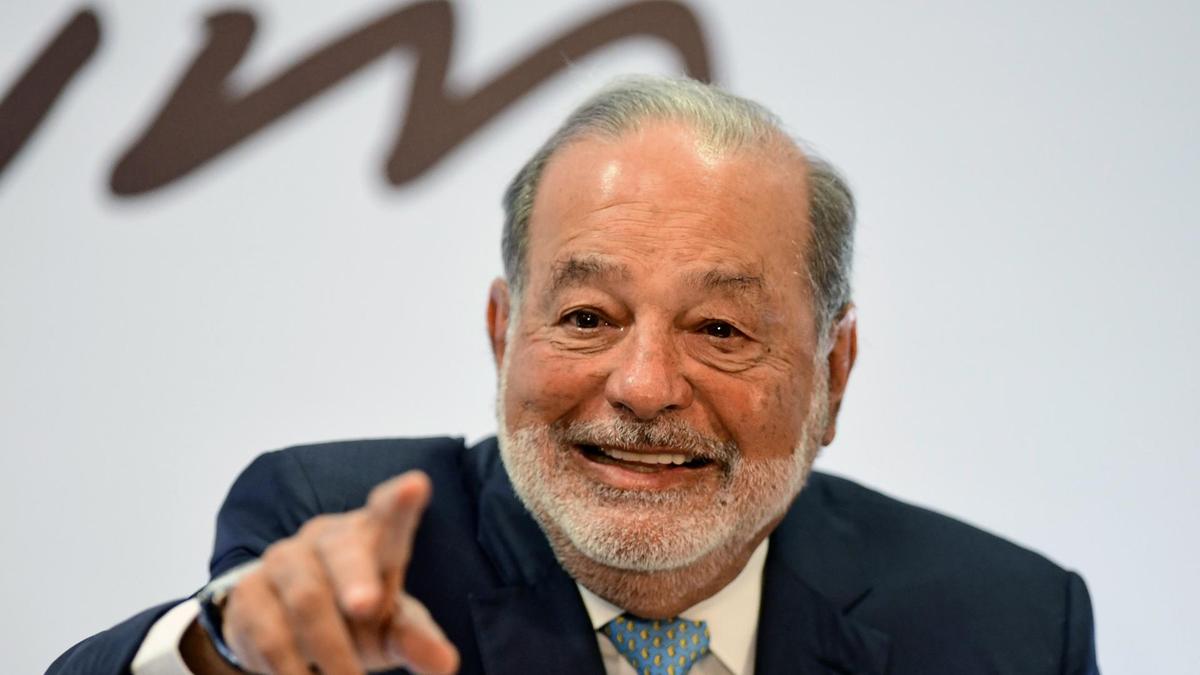Imagine if the grocery store, the cell phone provider, and biggest national construction outfit were all owned by the same company. You could buy just about anything and never have to enrich any competitors. That’s essentially the situation in Mexico, where one of the world’s richest people, Carlos Slim Helú, resides.
Here’s how billionaire Carlos Slim built his fortune
Early Life
Carlos Slim was born on Jan. 28, 1940, in Mexico City, Mexico. His parents, Julián Slim Haddad and Linda Helú Atta, were both Maronite Catholics of Lebanese descent. Carlos’ father, born Khalil Salim Haddad Aglamaz, was sent to Mexico in 1902 to avoid being drafted into the Ottoman Army. After arriving in Mexico, Carlos’ father changed his name to Julián Slim Haddad.
The family was part of a small but commercially prosperous community of Lebanese Christians who poured into Mexico in the late 1800s and early 1900s.
In a community devoted to commerce, Julian Slim was a natural, opening a dry goods store in 1911, which grew to offer more than $100,000 worth of merchandise just 10 years later. With proceeds from the store, he would go on to buy prime real estate in Mexico City for a pittance during the 1910-1917 Mexican Revolution.
His savvy investments in real estate, along with his continued success as both a retailer and a wholesaler made Julián a rich man, with a net worth of more than 1 million pesos.
From a young age, Carlos took an interest in his father’s business. And his father happily obliged with business lessons about management, reading financial statements and keeping accurate financial records.
In 1953, when Carlos was only 13 years old, his father died. After his father’s death, the young man continued to work for his late father’s company, which would ultimately be passed on to him. When Slim graduated high school, he went on to the National Autonomous University of Mexico, where he studied civil engineering while teaching algebra and linear programming.
While studying civil engineering, Slim also took an interest in economics, taking a series of courses on the subject in Chile after he graduated in 1961. He went into finance shortly afterward, working long, grueling days as a stock trader in Mexico City.
By 1965, at the age of 25, his trading had netted him roughly $400,000, more than $3 million in present dollars. He used the money to open his own brokerage firm, called Inversora Bursátil.
One of his biggest opportunities was the peso crisis in the early 1980s, coupled with a steep decline in oil prices. Capital was fleeing the country, and Slim bought a number of companies at depressed valuations. Some examples are Cigatam (the country’s second-largest cigarette maker), Reynolds Aluminum, General Tire and the Sanborns chain of stores.
A Wide Reach

Slim has a hand in literally hundreds of other companies, largely through Grupo Carso SAB, Slim’s global conglomerate. Grupo Carso has or has had stakes in enterprises as diverse as Elementia, one of the largest cement companies in Mexico, retail including Sears and Saks Fifth Avenue, energy and construction (via CICSA) and automotive (via Grupo Condumex). He even has a stake in The New York Times.
Perhaps the biggest piece of Slim’s wealth comes from telecommunications. Slim is the owner of América Movil, formerly Teléfonos de Mexico, or Telmex. Telmex was the old telephone monopoly in the country, akin to America’s AT&T Inc. (T). In the 1990s, the government privatized the company, and Slim was one of the initial investors, via Grupo Carso (the other members of the consortium were France Télécom and Southwestern Bell Corporation). The price: $1.8 billion, half of which was put up by Grupo Carso, for a 20% stake. Carlos Slim was at the helm of Grupo Carso and, as such, took over at Telmex.
By 2012, América Movil, Slim’s mobile telephony company, had taken over Telmex and made it into a privately held subsidiary. América Movil, via the subsidiary Telcel, has a market share approaching 70% of the mobile phone line market, and 80% of the landlines in Mexico. Now the company is poised to sell assets to bring its market share below 50%, in the wake of new anti-monopoly regulations in Mexico. But Slim is probably not upset that the various assets, such as cell phone towers, could easily bring in $8 billion or more – quite a profit on the original investment.
Not Just Mexico
América Movil, through various subsidiaries, isn’t just in Mexico. In the U.S., the most visible brand is TracFone, a low-cost cellular phone operator. In Austria, the company owns a majority stake in Telekom Austria. Slim’s telecom empire reaches almost every country in Latin America.
Yet it wasn’t necessarily a deep knowledge of technology or telecommunications that made the company what it is today. Slim has often said that his strategy is to reinvest the profits into the business itself and fuel growth. Telmex, for example, invested billions over several years to install an updated fiber network in the 1990s, and that left the company in a position to offer high-speed internet service.
The pattern is typical of Slim’s business deals over the course of his life – buy an asset, reinvest and sell at a profit. Telecommunications is only the most visible piece of that strategy.
Turnaround Specialist
Slim’s strategy has been to buy up sometimes troubled companies and try to turn them around. The advantage of that model is that it doesn’t necessarily require a specific knowledge of any given sector – just a keen sense of what is undervalued and what isn’t. (For more, see “Value Investing: Find Undervalued Stocks.”)
Also, the conglomerate structure allows him to have stakes in such a diverse range of industries that his wealth is well prepared to maneuver global financial turbulence. His stocks might lose value in a general market downturn that affects the whole economy, but a problem in the telecommunications industry won’t hurt his numbers much because some other sector will likely be doing reasonably well.
Slim is also less interested in the fine details of the businesses he buys. Any transaction is just that – the goal is to sell his stake at a profit later. For instance, his purchase of a stake in The New York Times is less about editorial policy and more about the idea that the paper can gain value as an asset, as Eduardo Garcia, editor of Sentido Común, a financial news site, told the American Journalism Review in 2009.
Carlos Slim Corners the Market
Another issue is monopolistic practices. One of the assets Slim picked up with Telmex was one of the largest Mexican makers of copper wire. He then stopped Telmex from buying wire from the company’s competitor. For years, the Mexican government has fought to curb Slim’s dominance in the telecommunications sphere.
However, when the Mexican government attempted to increase competition in the phone business, it didn’t account for the fact that new companies had to pay Telmex an interconnection fee. Telmex simply set such fees very high, making it tougher for any other provider to undercut prices, especially for long distance calls. Eventually, the practice stopped, after much negotiation between the government, Slim and the upstarts. (For more, see “How Monopoly Antitrust Laws Affect Consumers.”)
Even when anti-monopoly laws force Slim’s companies to sell assets, there’s a sense that it might just be an end-run around the law. For example, in January 2014, a Mexican court ordered Telmex to stop selling a division that holds fiber optic lines and telephone poles. The aim was to sell the division, since once the division was no longer part of Telmex, the company likely wouldn’t fall under certain antitrust rules anymore, giving Slim a freer hand.
Critics have noted that with Slim’s companies owning such large market shares, and driving out competitors, the Mexican economy has suffered. A lack of an even playing field means that new entrants have a tougher time mounting a challenge to an incumbent player.
Slim’s Monopoly and Its Challenges
In 2015, Slim was the second-richest man in the world according to Forbes, but the Mexican tycoon fell to fourth place and was the biggest dollar loser on the 2016 Forbes Billionaires List, In 2017, he slipped to sixth.
The weak peso and new Mexican regulations have hurt Slim’s businesses tremendously recently. Over the years, the Mexican government has ramped up its efforts to curtail Slim’s near monopolies. In 2014, Mexican President Enrique Pena Nieto signed a law aimed at increasing competition in the telecommunications arena.
Essentially, the law forced Slim’s primary enterprise América Móvil to submit to special rules since it is the main competitor in the telecom field. América Móvil could not charge fees to its smaller competitors if they used the company’s network and the firm must share its infrastructure, such as its cellphone towers, with its competitors. Slim said these regulations essentially forced América Móvil to subsidize its competitors, and in August 2017, Mexico’s Supreme Court ruled that allowing competitors to use América Móvil’s network free of charge was unconstitutional, although it did not require competitors to pay retroactive fees to the company.
América Móvil held 72% of the Mexican wireless market in 2016, according to the Organization for Economic Cooperation and Development (OECD). However, AT&T is spending billions to compete with América Móvil. New challenges lie ahead for the telecom giant in upcoming years.
Notable Real Estate
Not an area that Slim focused on in his early years, real estate has become a major part of his portfolio in the past two decades. Part of this was a natural undertaking as part of the expanding conglomerate, such as the 20 shopping centers throughout Mexico, 10 of those in Mexico City. However, in 2006, Slim purchased the Duke Semans mansion for $44 million, considered one of the last great private residences on Fifth Avenue in New York City. In 2015, it was put up for sale for $80 million but taken off the market in 2016 when he could not find a buyer.
Slim also purchased two commercial buildings in the United States in 2015, including the PepsiCo Inc. (PEP) Americas Beverages’ headquarters just north of New York City and the Marquette Building in Detroit. Grupo Carso’s main complex headquarters in Mexico City, named Plaza Carso, includes the Museo Soumaya, Museo Jumex, the Plaza Carso Shopping center, three residential towers and three commercial office buildings completed at an estimated cost of $1.4 billion.
Finally, Slim’s late wife was an avid art collector, and he built the Museo Soumaya in her honor. It houses almost 70,000 works of art, including the largest collection of Rodin art outside of France, as well as a host of masterpieces by Matisse, Van Gogh, Monet and Dali, just to name a few.
The Bottom Line
Slim’s fortune is more like that of the old Rockefeller family than that of Bill Gates. Instead of building an empire on a few great innovations in a particular field, he did so through acquisitions and building a nearly unassailable market share.




